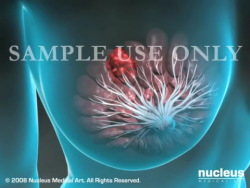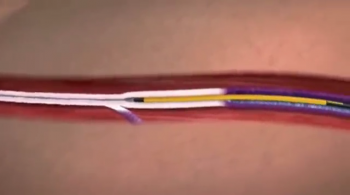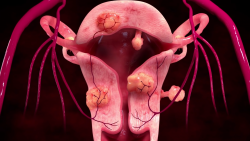
Radiofrequency (RF) ablation has been gaining popularity as a minimally invasive treatment for benign thyroid nodules regardless of the extent of the solid component. RF ablation of benign nodules demonstrated efficient volume reductions, while solving nodule-related clinical problems.
In brief, RF ablation uses the heat generated from high-frequency alternating electric current oscillating between 200 and 1200 kHz [11]. The RF waves passing through the electrode agitate tissue ions around the electrode, and they increase the temperature (by frictional heat) within the tumor tissue, thus resulting in the destruction of tumor located very close, that is, within a few millimeters, to the electrode. In addition to the frictional heat, conduction heat from the ablated area can result in relatively slower damage of the tumor or to tissue remote from the electrode tip. This process of thermal injury secondary to friction and conduction heat is the basic mechanism of RF ablation.
Treatment Indications
RF ablation can be used to treat both benign thyroid nodules and inoperable, recurrent thyroid cancers located in the surgical bed as well as lymph nodes [14–28]. Indications for RF ablation of benign thyroid nodules are nodule-related clinical problems such as symptoms, for example, neck pain, dysphasia, foreign body sensation, discomfort, and cough, cosmetic problems, or thyrotoxicosis in cases of autonomously functioning thyroid nodules (AFTNs).
Procedures for Thyroid RF Ablation
The patient is placed in the supine position with mild neck extension, after which a grounding pad is firmly attached to each thigh. With the transisthmic approach, the electrode is inserted from the isthmus to the lateral aspect of a targeted nodule. The entire length of the electrode can be visualized via a transverse US view and with minimal heat exposure to the danger triangle which includes the recurrent laryngeal nerve and/or the esophagus. Secure positioning of the electrode through sufficient thyroid parenchyma also prevents leakage of ablated hot fluid outside the thyroid gland and change in the electrode position during swallowing or talking.
Complications
Pain is the most common patient complaint during RF ablation, although the pain decreases rapidly when the generator output is reduced or turned off.
Voice change is a rare complication of RF ablation and is likely due to injuries to the recurrent laryngeal nerve or hemorrhage.
Hematomas can usually be controlled by compressing the neck for several minutes. Serious perithyroidal hemorrhage may be prevented by examining the perithyroidal vessels before inserting the electrode and with the use of small-bore electrodes.
Hematomas can usually be controlled by compressing the neck for several minutes. Serious perithyroidal hemorrhage may be prevented by examining the perithyroidal vessels before inserting the electrode and with the use of small-bore electrodes.
Nodule rupture presents with sudden neck bulging and pain during the follow-up period. It is secondary to the acute volume expansion of a nodule due to hemorrhage. This complication can usually be managed conservatively with antibiotics and/or analgesics.
We’ve experienced none of forementioned complications and they are very rare in hands of experienced clinicians.
RF ablation is a safe and effective alternative to surgery for treating benign, nonfunctioning, or autonomously functioning nodules as well as for recurrent thyroid cancers. Its efficacy can be maximized by complete ablation of the entire tumor margin, which is essential in order to prevent marginal regrowth and to effectively reduce the size of thyroid nodules.



Leave a Reply
Want to join the discussion?Feel free to contribute!